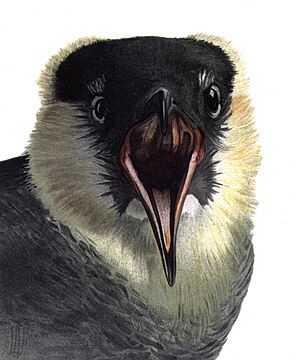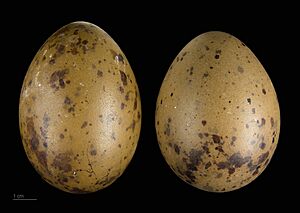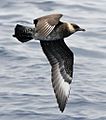Pomarine jaeger facts for kids
Quick facts for kids Pomarine jaeger |
|
|---|---|
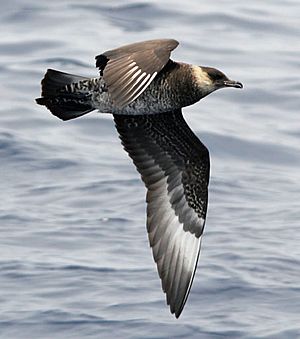 |
|
| Conservation status | |
| Scientific classification | |
| Genus: |
Stercorarius
|
| Species: |
pomarinus
|
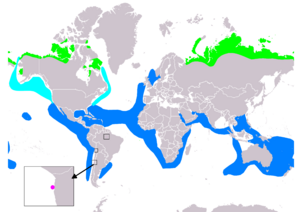 |
|
| Range of S. pomarinus Breeding Non-breeding Passage Vagrant (seasonality uncertain) | |
| Synonyms | |
|
|
The pomarine jaeger (Stercorarius pomarinus), also called the pomarine skua, is a type of seabird. It belongs to the skua family. This bird travels long distances, spending its winters in warm ocean areas.
Contents
What's in a Name?
The word "jaeger" comes from the German word Jäger, which means "hunter". This name fits well because these birds are skilled hunters.
The genus name Stercorarius is Latin. It means "of dung". Long ago, people thought the food skuas stole from other birds was actually waste.
The specific name Pomatorhinus comes from Ancient Greek words. It refers to a special part of the bird's nose called the cere. The pomarine jaeger shares this feature with other skuas.
Appearance and Size
The pomarine jaeger is a large bird. It can be from 46 to 67 centimeters (18 to 26 inches) long. Its wings can spread up to 110 to 138 centimeters (43 to 54 inches) wide. It weighs between 540 and 920 grams (1.2 to 2 pounds). The longest tail feathers of adult birds can add about 10 centimeters (4 inches) to their length.
It can be tricky to tell this bird apart from other skuas. This is because it looks similar to the parasitic jaeger. Also, pomarine jaegers come in three different color types, called morphs.
Pomarine jaegers are bigger than common gulls. They have wider wings and look stronger than the parasitic jaeger. Their flight is steady and powerful. They make loud chattering sounds and calls that sound like which-yew.
Color Morphs
- Light-morph adults have a brown back. Their bellies are mostly white. Their main wing feathers are dark with a white "flash" or patch. Their head and neck are yellowish-white with a black cap.
- Dark-morph adults are dark brown all over.
- Intermediate-morph birds are dark but have lighter bellies, heads, and necks.
All color types have a white flash on their wings. This flash looks like a double flash when seen from below. In breeding adults, the two central tail feathers are much longer than the others. They are spoon-shaped and twisted. Young birds are even harder to identify. It is tough to tell them apart from young parasitic jaegers just by their feathers.
Life and Behavior
Reproduction
This bird breeds in the far northern parts of Eurasia and North America. It builds its nests on Arctic tundra and islands. The female lays 2 to 3 olive-brown eggs in a shallow dip in the ground. The nest is lined with grass.
Like other skuas, the pomarine jaeger will fly at the head of anyone who comes too close to its nest. While it usually does not cause serious harm, it can be a scary experience.
Feeding Habits
The pomarine jaeger eats many different things. It feeds on fish, dead animals (called carrion), and scraps. It also hunts smaller birds, even those as big as a common gull. Rodents, especially lemmings, are also a favorite food.
This bird is known for its "pirate" behavior. It often steals food from other birds. It will chase gulls, terns, and even gannets until they drop their catch. The pomarine jaeger is very agile and quick when it harasses its victims. It does this stealing behavior all year round.
Only a few large birds are known to hunt healthy adult pomarine jaegers. These include the Great Black Backed Gull, the White-Tailed Eagle, and the Golden Eagle.
Images for kids



